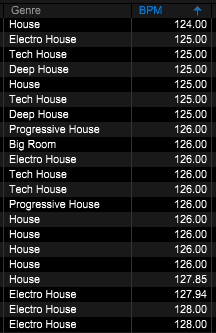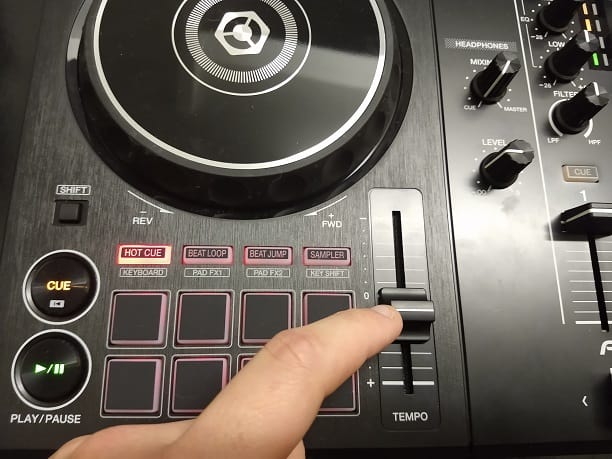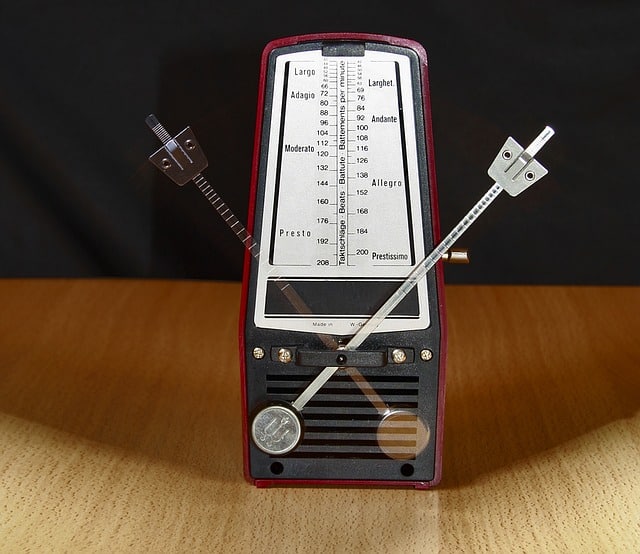Every electronic dance music genre and other genres have a range in which the tempo of their music can vary, which is also the case for house music. We can express the tempo of a song in beats per minute (BPM). Most people mean with house music, a genre, a subgenre of house music, or they mean a genre combined with its subgenres.
The music of the house music genre has a tempo that varies from 115 to 130 BPM, and the most common tempo for this music is 128 BPM. The music of the house music subgenres have a similar tempo range, and also for these genres the most common tempo for it is music 128 BPM.
This post first explains briefly what house music and a tempo is, and then there follows some example tempos of some house genres. After that, there follows information about genres with an unknown tempo, and that tempo of music can change. At last, there follows information about why to play music at a different tempo, why 128 BPM is popular, and the origin of the house tempo.
Explaining Briefly House Music and Tempo
Beats per minute (bpm) is the tempo of a track determined by how many beats per minute the track plays. The more beats per minute, the faster the track is.
Here is an extremely short explanation about the history of house music. Around 1979 the popularity in disco music started to decrease a lot, and around the early 1980s in Chicago, disco music evolved into house music. Furthermore, the first house track ever is Jesse Saunders – On and On.
The house music genre expanded as time passed, and it probably always keeps expanding.
The Tempo of Some House Music Genres
Most of the house music subgenres all have a slightly different range in which the tempo of their tracks can vary. There are many of those subgenres, and to my opinion, way too many to list here. Knowing from some of those subgenres their tempo range can help to form a better understanding of the tempo of house music and it’s subgenres.
Here in the table below are some (not all) well-known house music subgenres with their tempo range in BPM. As we can see in this table, the slowest tempo is 110 BPM, and the fastest is 135 BPM. However, this does not mean that there is not a house music subgenre with a slower or faster tempo.
| Genre | A tempo in BPM that varies |
|---|---|
| House music | from 115 to 130 BPM |
| Big room house | from 126 to 132 BPM |
| Deep house | from 110 to 125 BPM |
| Electro house | from 125 to 135 BPM |
| Progressive house | from 120 to 135 BPM |
| Tech house | around 125 BPM |
House Subgenres with an Unknown Tempo
As mentioned above in the previous section, the house genre has many subgenres with some rare ones. Also, when time passes, this genre will probably always get some new subgenres in its collection.
With all those house subgenres, there might be or arise a problem that we have a subgenre by which we cannot find the tempo range of its music. However, by looking at the tempo range of the house genre, we can tell more about the tempo range of the house subgenre. All of such subgenres are related to the house genre, and also its tempo range.
Using the House Genre for Determining the Tempo of the House Subgenre
If we don’t have any tracks from a house subgenre by which we want to know it’s tempo range, then we can only assume what it would be. We can assume that the tempo range of the house genre is the same or almost the same as the tempo range of its subgenre.
When we have some tracks that are part of a house subgenre by which we want to know it’s tempo range, then we have at least the tempo of these tacks. We can see the tempo of these tracks as boundaries of a tempo range. For example, we have a track on 118 BPM and another track on 132 BPM, then the tempo range of these two tracks is from 118 BPM to 132 BPM.
We can combine the tempo range of some tracks of a house subgenre with the tempo range of the house genre. We can do such combining by taking the slowest and the fastest tempo of both tempo ranges. These two tempos become the two boundaries of the combined tempo range.
For example, we have determined a tempo range of some tracks, which is 118 from to 132 BPM, and the tempo range from house music is from 110 to 130 BPM. From these to two ranges, we take the slowest tempo, which is 110, and the fastest tempo, which is 132. These two tempos are the boundaries of the combined tempo range, which is a range from 110 to 132 BPM.
As a side note, using the tempo range of the house genre never gives assurance in determining the tempo range of a house subgenre, it’s more a guideline.
Finding the Tempo of a Track
There are some (not all) methods by which we can try to find to the tempo of a track, which are:
- Search on Google. A method to search on Google is to type the track name with “BPM” or “tempo” behind it, which probably always gives many search results. For example, Mr. Fingers – Mystery Of Love BPM.
- Search in a store. Some stores, such as Beatport, shows the BPM of the tracks they sell. If the store has the track by which we want to find the BPM of it, then such a store shows will show it.
- DJ software can show the tempo. The DJ software Rekordbox shows in my experience always the correct BPM of tracks, see image directly below. Most other DJ software probably also tries to show the correct BPM of tracks.
These methods don’t always work, but will probably most of the time.

House Music on a Different Tempo, Can Go Outside Its Range
We can play and listen to a house music track (song) on a different tempo than its original tempo. For example, we have a track with a tempo of 118 BPM, and we play this track on a tempo of 98 BPM.
By playing a house music track slower or faster than its original tempo, we can go outside the house music tempo range. This range is a tempo that varies from 110 to 130 BPM.
A side note, playing a track faster or slower than its original tempo doesn’t mean it sounds better or something like that.
There are many possibilities by which we can play a track on a different tempo, such as playing the track at a slower speed in a media player. Furthermore, a common method to play a track on a different tempo is with DJ gear, such as a DJ controller.

Most (or all) of the DJ controllers have a function to change the tempo of a playing track. The next section explains some reasons why someone would change the tempo of a playing track.
Reasons to Play House Music on a Different Tempo
Here follow some (not all) reason why someone would play a house track on a different tempo:
- Matching the tempo of another track. Someone who is DJing can change the tempo of the current playing track to match the tempo of an upcoming track. Without matching the tempo of an upcoming track, the mixing from the current track to the upcoming track sounds bad.
- Mimic or create a different genre. When we play a track slower or faster than the tempo range of its genre, then it doesn’t sound anymore like its part its genre. There is a post on this site, about how Dave Nada discovered the genre moombahton by playing an electro house track slower than its original tempo.
- Creativity. The possibilities are probably endless with changing the tempo of a track. An example is changing it many times in extreme amount while playing the track.
Reasons Why the 128 BPM Tempo Is Popular
The reasons why the 128 BPM tempo is popular is a big topic, and in my opinion, too big for this post. However, here are a few reasons, which are not complete and briefly explained, which gives hopefully an impression why the tempo is popular:
- Many people can dance on a 128 BPM tempo.
- It is easier for a DJ to mix from track to another track if they both have the same tempo. The more tracks there are 128 BPM, the more possibilities for such easy mixing.
- When a part of a track is 16 bars long, and the tempo of the track is 128 BPM, then those 16 bars are 30 seconds long. As a side note, one bar is four beats, which is one house music (in the active parts), a bass drum (kick) on every beat. Such calculations of 30 seconds can help some producers, DJs, and can help syncing music with videos.
- There are many EDM production tutorials (and similar), which is also the case for house music with its subgenres. Many of these tutorials explain that 128 BPM is fine and a common tempo to use.
Originate of the House Tempo
The tempo of house music came directly with the first house music tracks ever. So, when the house genre came, it directly also had its tempo range, and there is no information about if that range became broader as time passed.
If someone is interested in checking how the tempo evolved, then there is a solution, which takes an extreme amount of time. The solution is to check as good as every track ever made up to now for its tempo.


1 comment